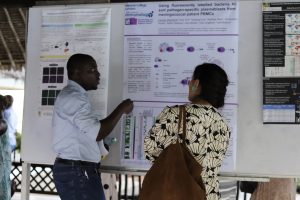Earlier this year, the Institute of Infection began the recruitment of several Early Career Researcher Champions. They have wide-ranging research foci and stories, which we will share via this blog.
 To be introduced first is Dr Fadil Bidmos, an Advanced Research Fellow in the Department of Infectious Disease. Fadil’s research focuses on developing novel and cheap-to-produce vaccines that will target the two leading causes of bacterial meningitis, the meningococcus, and pneumococcus.
To be introduced first is Dr Fadil Bidmos, an Advanced Research Fellow in the Department of Infectious Disease. Fadil’s research focuses on developing novel and cheap-to-produce vaccines that will target the two leading causes of bacterial meningitis, the meningococcus, and pneumococcus.
Meningitis is an inflammation of the protective membranes covering the brain and spinal cord. It can be caused by bacterial, viral, and in rare cases, fungal or parasitic infections. While viral meningitis is the most common, bacterial meningitis is associated with the most serious mortality and morbidity. According to the National Institute for Health and Care Excellence (NICE), bacterial meningitis affects 1 per 100,000 people in the UK. Despite the availability of vaccines for the most common causes, bacterial meningitis remains a major global health challenge, including being a significant threat to the 450 million people living in the 26 countries in Africa’s Sub-Saharan ‘meningitis belt,’ which has the highest disease burden.
According to the WHO, just four types of bacteria are responsible for more than half of the deaths from meningitis globally, and they cause other severe diseases like sepsis and pneumonia.
“Around 1 in 6 people who get this type of acute bacterial meningitis die, and 1 in 5 have severe complications.” – The WHO.
Research to improve the understanding and treatment of bacterial meningitis is essential and must focus on identifying solutions that will benefit global populations. The development of cheap-to-produce vaccines is a significant component of this challenge, as Dr Bidmos explains.
Please describe your research, especially the parts involving meningitis.
My research focuses on developing novel and cheap-to-produce vaccines that will target the two leading causes of bacterial meningitis, the meningococcus, and the pneumococcus. We are using advanced tools, now available at our disposal, to develop this vaccine in a “next-generation” format.
How is your research helping to find a cure for meningitis, as there is already a vaccine for it?
While there are vaccines already licensed for use against meningitis, continuous efforts are required for further vaccine development as currently, available vaccines do not provide complete protection against the disease. Hence, my research seeks to fill the gap in protection that current vaccines do not offer. Antibiotics help cure meningitis. However, 15 out of every 100 individuals affected by the disease die because of misdiagnosis (early meningitis symptoms – fever, headache, lethargy – are non-specific) or late treatment intervention, even following antibiotic administration. Hence, prevention is better than cure, and vaccines are the preferred prophylaxis option.
What are meningococcal vaccine-candidate antigens, and how did you discover them?
In essence, a vaccine candidate antigen is one that: (1) can induce a functional immune response, (2) is present in abundant amounts on the bacterial surface, and (3) exhibits little to no variation from one type of bacterium to the next. Because of ongoing discussions regarding intellectual property (IP) rights, the exact identity of our identified antigen(s) cannot be revealed at this stage. However, the route to discovery involved an elegant approach known as Reverse Vaccinology 2.0 (RV 2.0).
In RV2.0, antibodies targeting the meningococcus (and, in a separate study, the pneumococcus) were cloned from patients recovering from the disease. These antibodies were tested for their ability to kill the meningococcus/pneumococcus in the lab. Those antibodies that could destroy the meningococcus or pneumococcus were next analysed for what antigen induced their production in the patient. Using RV 2.0, we have successfully identified antigens that have never been considered for vaccine candidacy for either of these pathogens and are, therefore, novel.
What do your meningococcal carriage studies involve?
Because the meningococcus exists in a harmless state in the throat of humans known as carriage, and this carriage state usually precedes disease (“accidental” entry of the bacterium into the systemic circulation), carriage studies inform on what types of the bacterium are circulating. This information helps meningococcal biologists and policymakers to design effective preventive (vaccines) and curative (anti-AMR) measures.
In a carriage study, throat swabs (and, in some cases, small blood samples) are taken from healthy individuals to assess the presence of the meningococcus in the throat, followed by elucidation via molecular genetic analyses of the type of the bacterium it is that an individual is carrying. The blood samples facilitate the assessment of the type, quantity, and quality of the adaptive immune response, if present, to the carried meningococcus or previous carriage events.
How vital is interdisciplinary research, and how have you used it in your research?
The more we understand about the aetiological agents of disease, the more we realise the magnitude of the effort required to diagnose, treat or prevent disease. The magnitude of this effort involves technologies stemming from different disciplines; hence, cross-talk between these disciplines is essential. For example, for developing a cheaper-to-produce glycoconjugate vaccine against bacterial meningitis using protein-glycan coupling technology (PGCT), our research group (composed of mainly microbiologists and immunologists) is collaborating with experts in glycobiology, some of whom are structural chemists. Delivery of such a vaccine may be most effective in a nanoparticle format, in which case the expertise of biophysicists will be required.
What can be done to reduce the number of antimicrobial-resistant meningitis cases?
From the preceding, effective vaccine development is an obvious solution, which robust epidemiological studies will engender. Alternative therapeutics such as novel antibiotic compounds and antibody-based compounds are another, but the latter requires further work as a complete understanding of the exact nature of the contribution of antibodies to pathogen clearance (especially in the case of pneumococcal meningitis) is currently unknown.
What are the critical challenges in meningitis research, and how can they be solved?
Quite a few stemming from different pathogen- and host-borne facets, but I’d like to highlight the diversity embedded in the genomes of and exhibited phenotypically by the pathogens. For example, a key vaccine component in currently available vaccines is the capsule, a water-filled envelope that encases the bacterium and protects it from desiccation during inter-host transmission and from host immune factors. More than 100 structural variants of this capsule exist for pneumococcus. With accruing data showing an inhibitory limit on the number of capsules that can compose an effective vaccine, vaccine research is thus complicated. The situation is much worse with proteins, of which more than 1000 variants can exist, e.g., the immunodominant meningococcal PorA protein.
Rational structure-based approaches in synergy with higher-throughput technologies could solve these challenges. Multicomponent vaccines, already utilised in the 4CMenB meningococcal vaccine, are a viable solution that will increase the breadth of coverage afforded by vaccines, i.e., each component may target a group of strains possessing non-overlapping/non-synonymous antigenic repertoires hence limiting the potential for vaccine escape.
What advances would you like to see in meningitis research in the next ten years?
Technologies/approaches that would facilitate the development of mucosal vaccines.
To help raise awareness on meningitis, do you have a message or call to action for other researchers that you would like to share?
Suppose the clinical endpoint of prevention of asymptomatic infection is too arduous a task to fulfil for vaccines in trials, but prevention of disease is easier to attain. Shall we consider lowering the licensure bar if the latter at least protects that extra life? For example, the 4CMenB vaccine and its usefulness against invasive meningococcal disease incidence in infants.
 What opportunities would you like ECR to have to help with your careers?
What opportunities would you like ECR to have to help with your careers?
Funding and individuals in our “Personal boardroom” that fulfil the power roles, i.e., unlocker, sponsor, influencer, and connector.